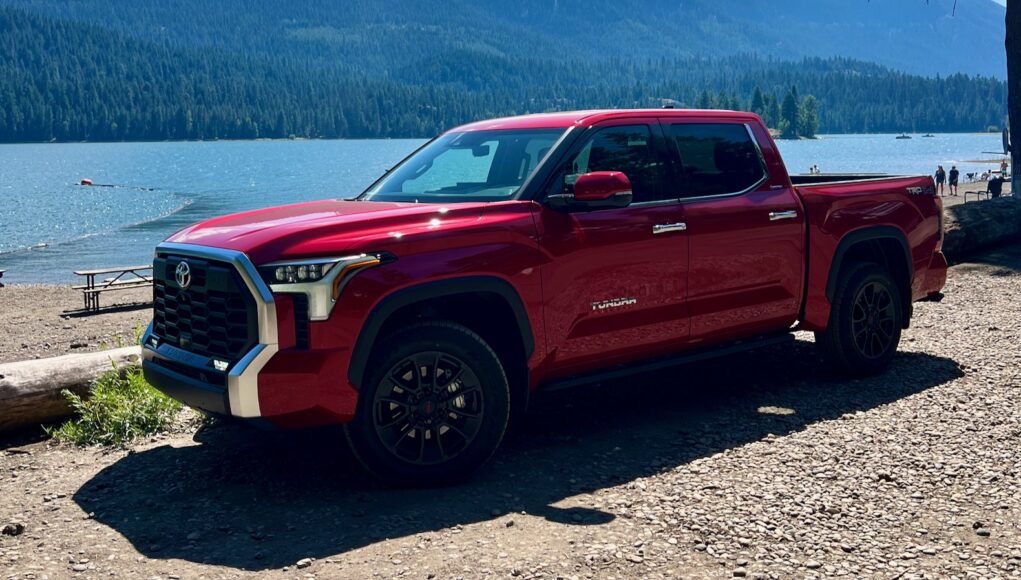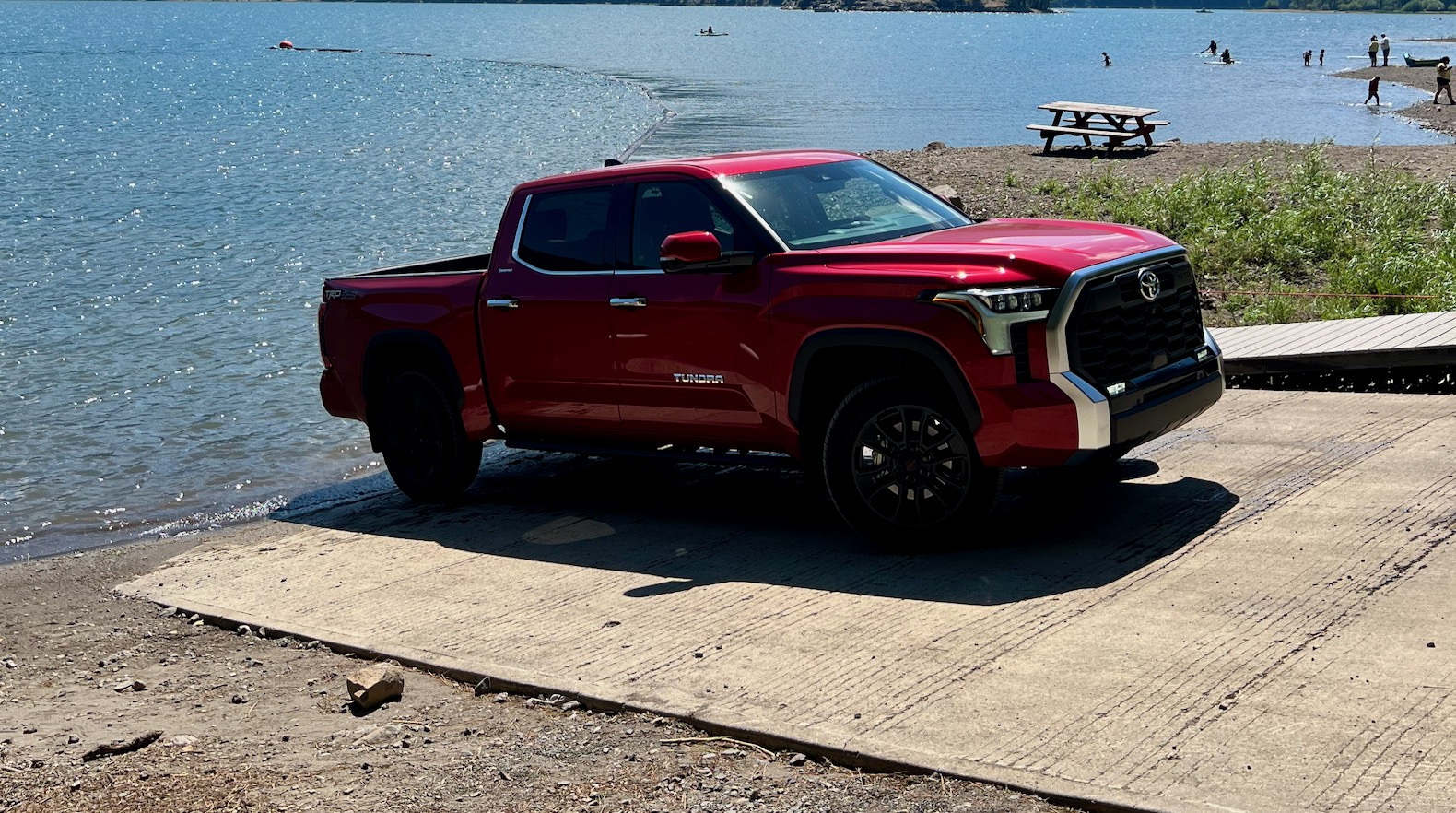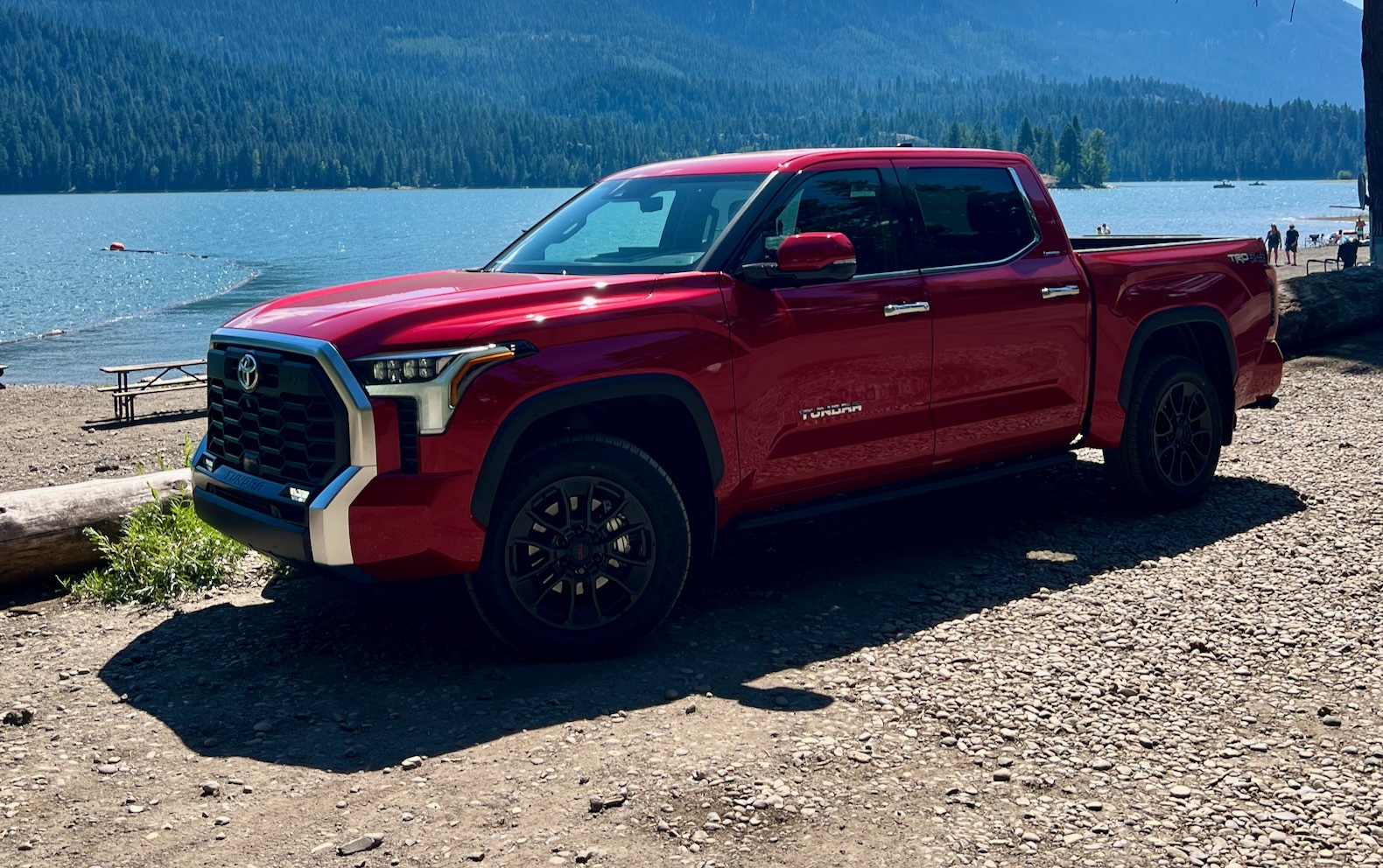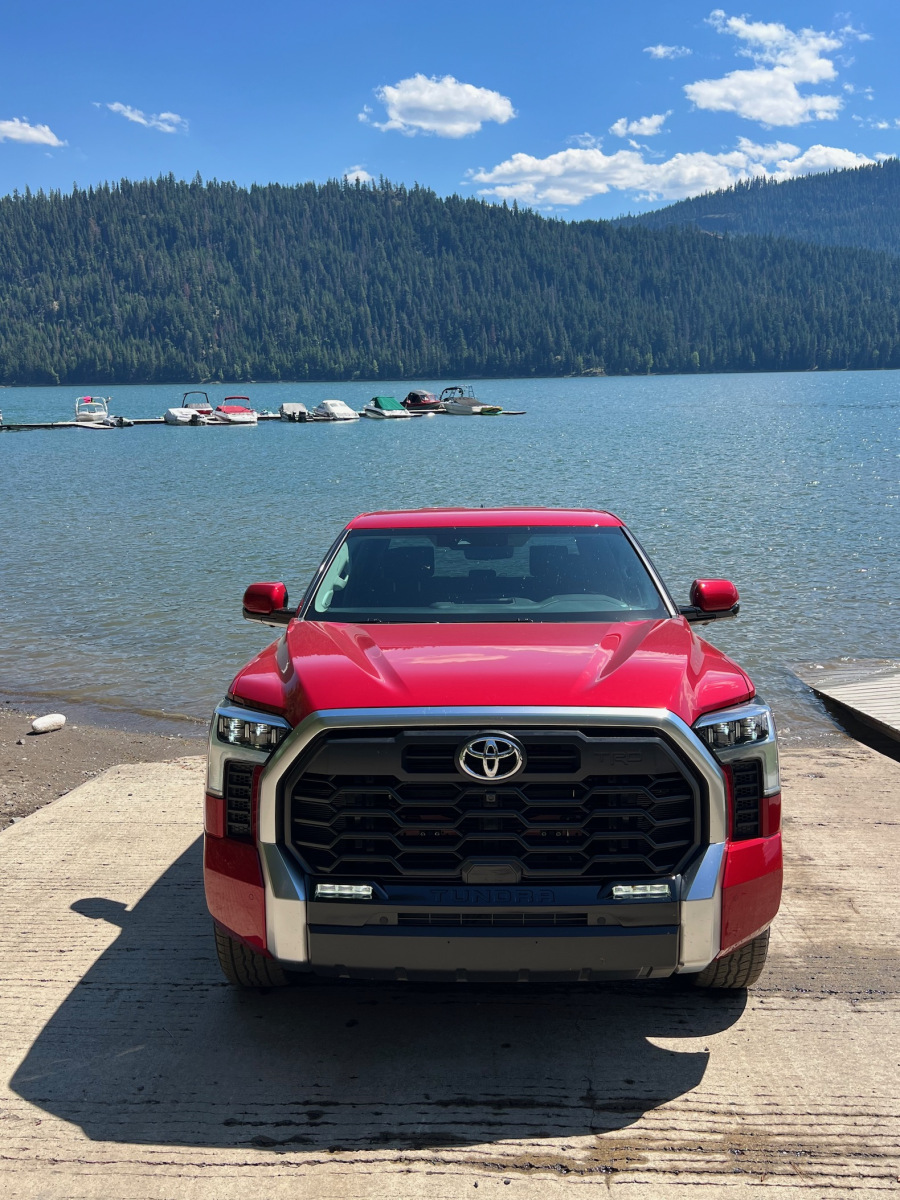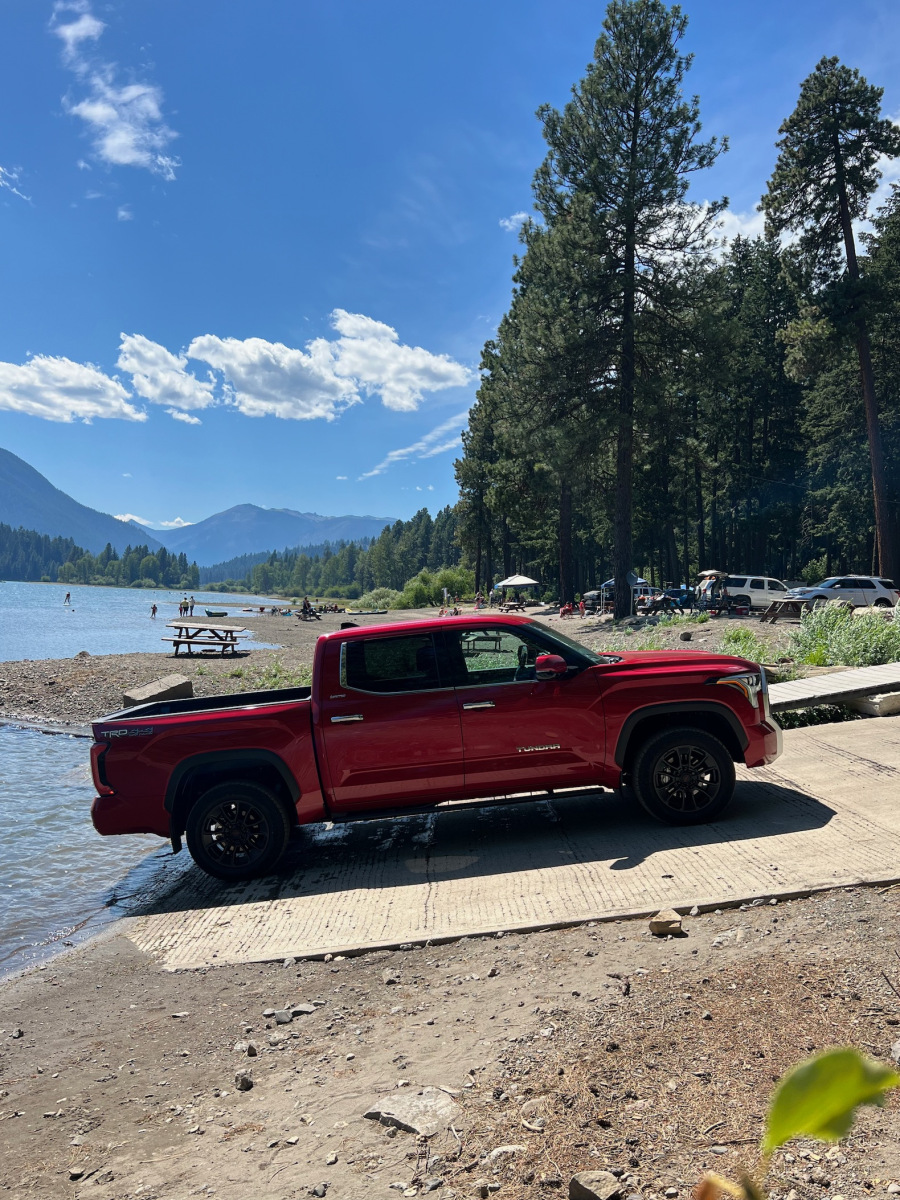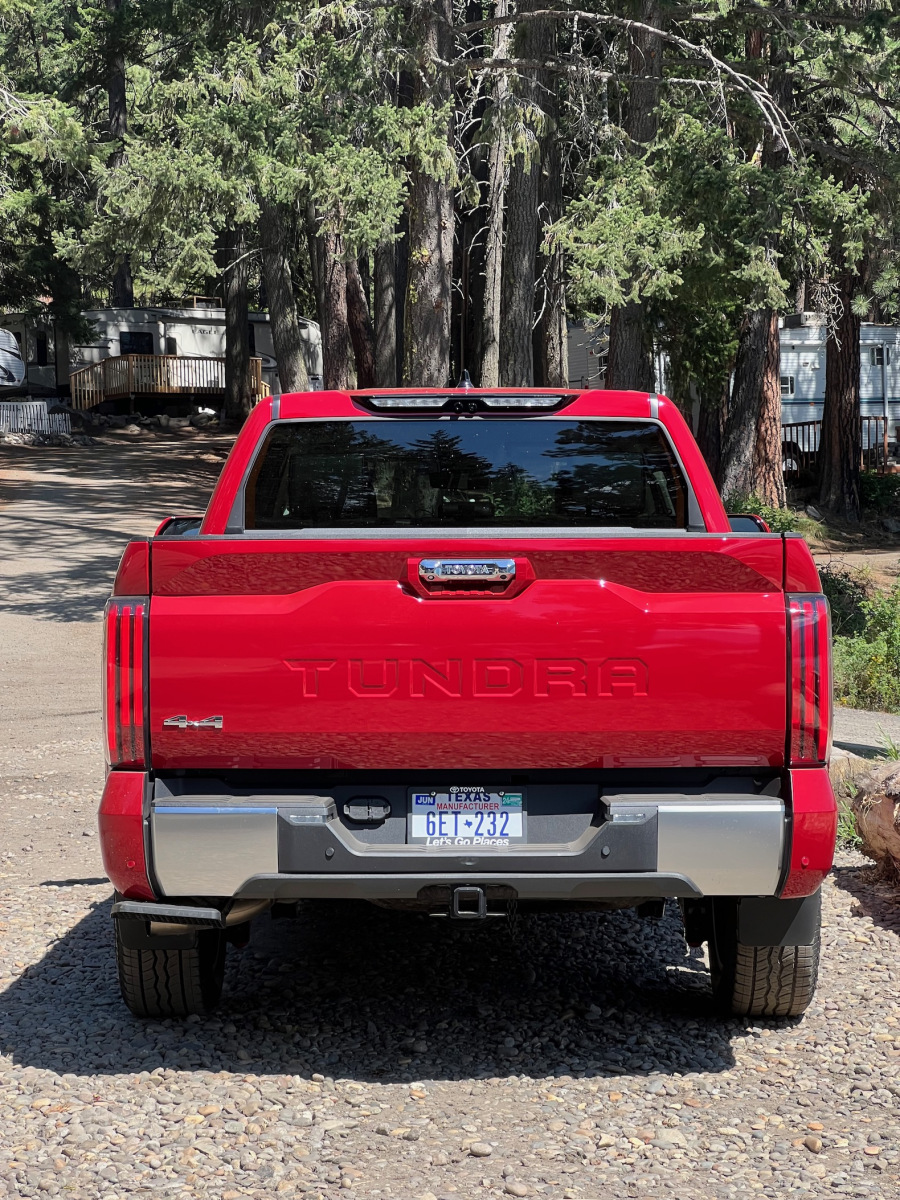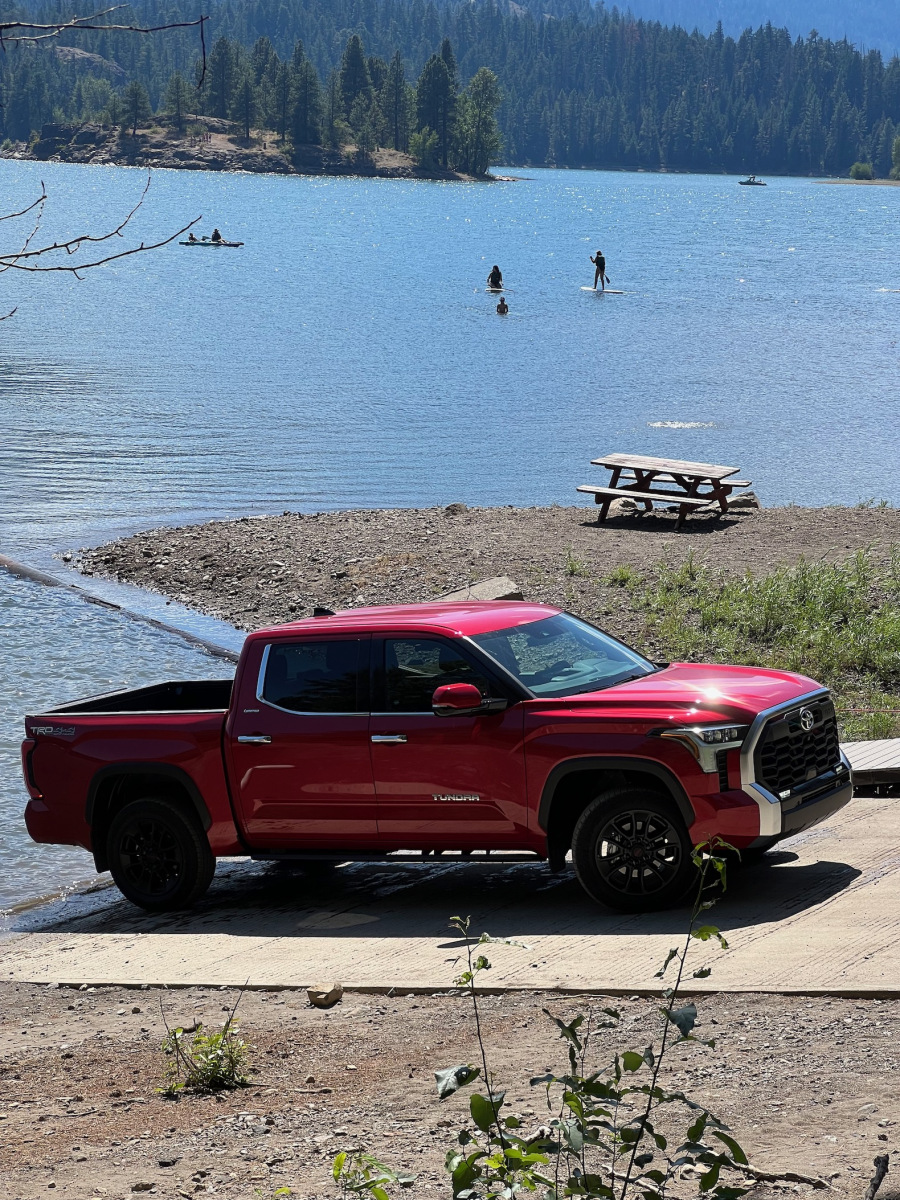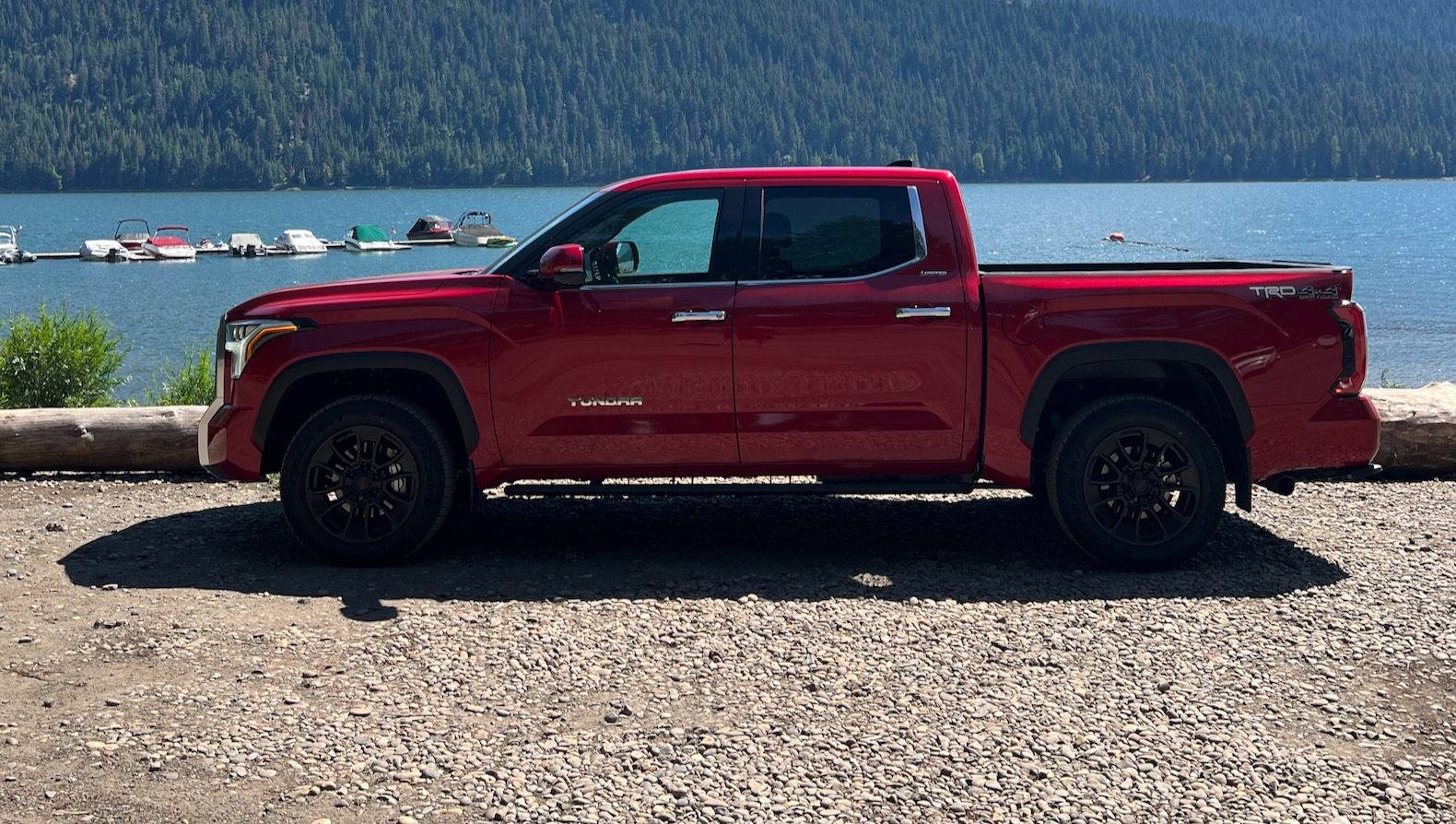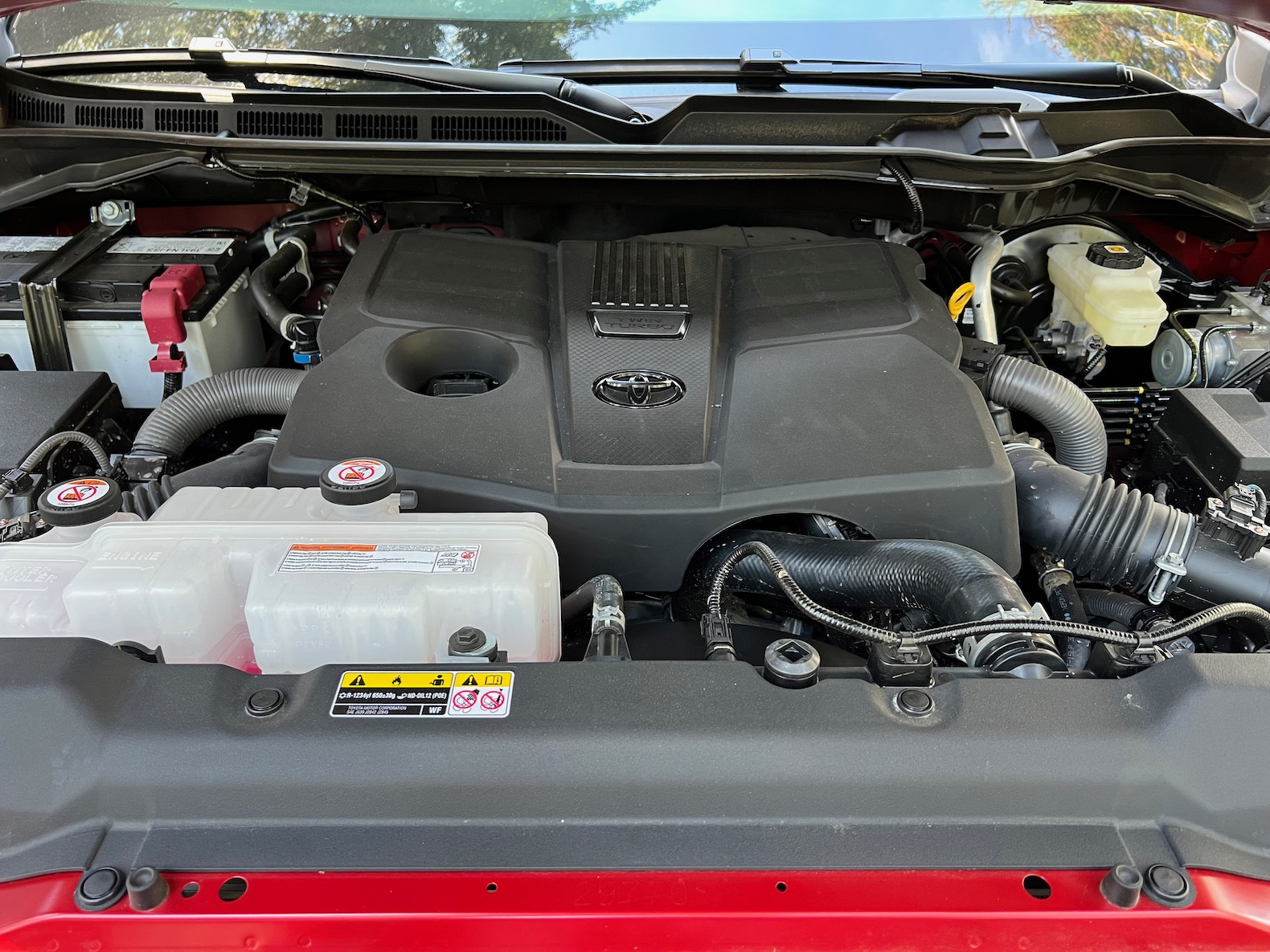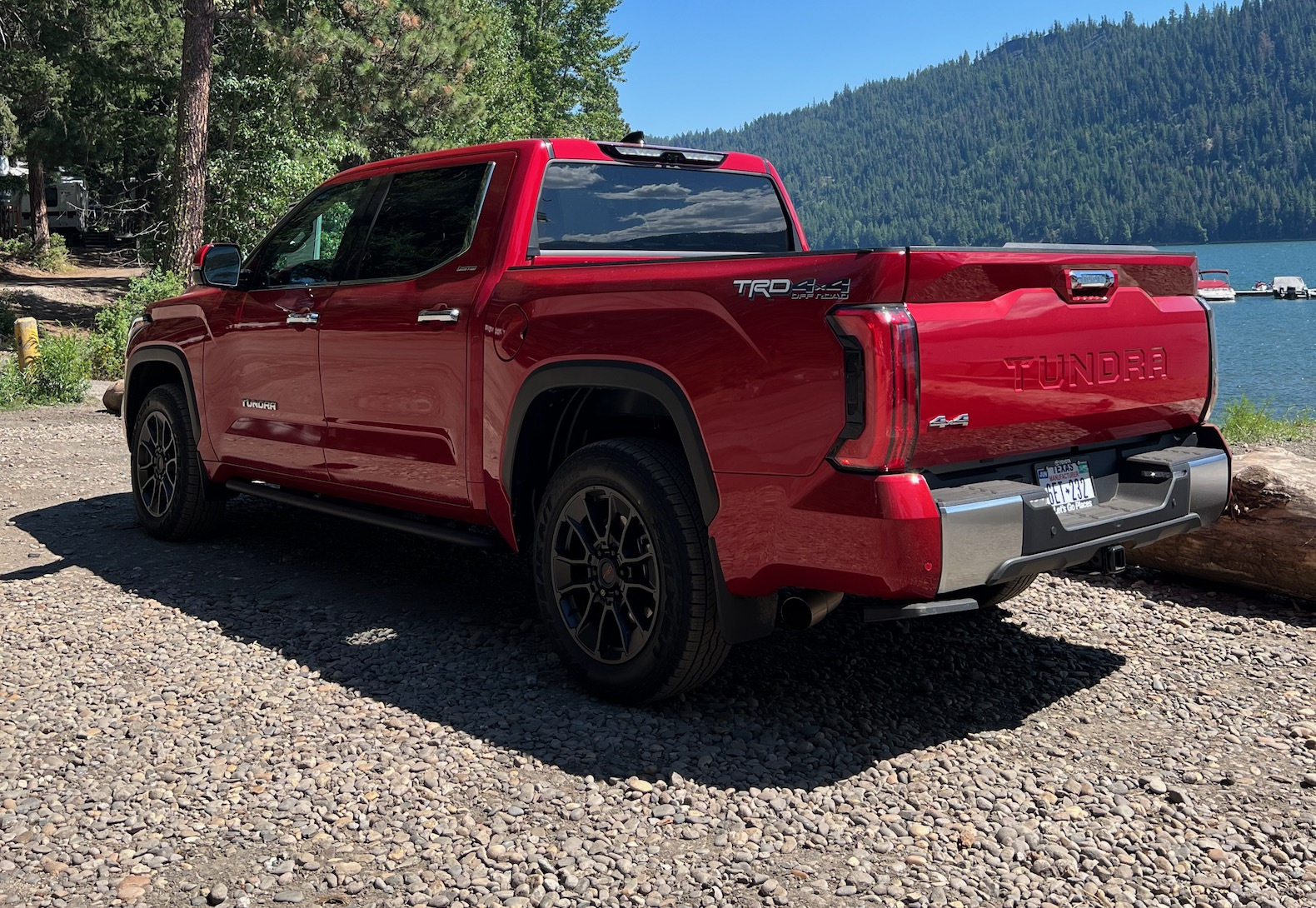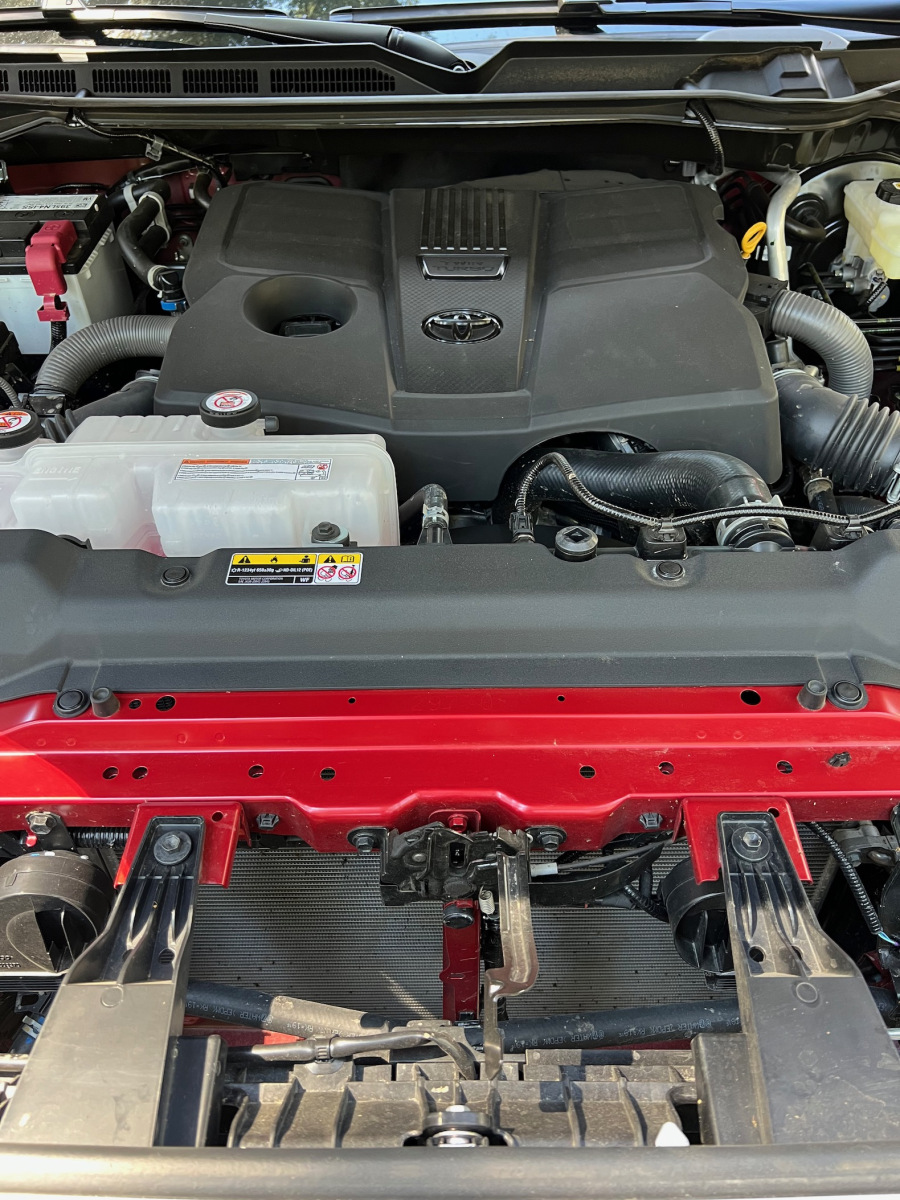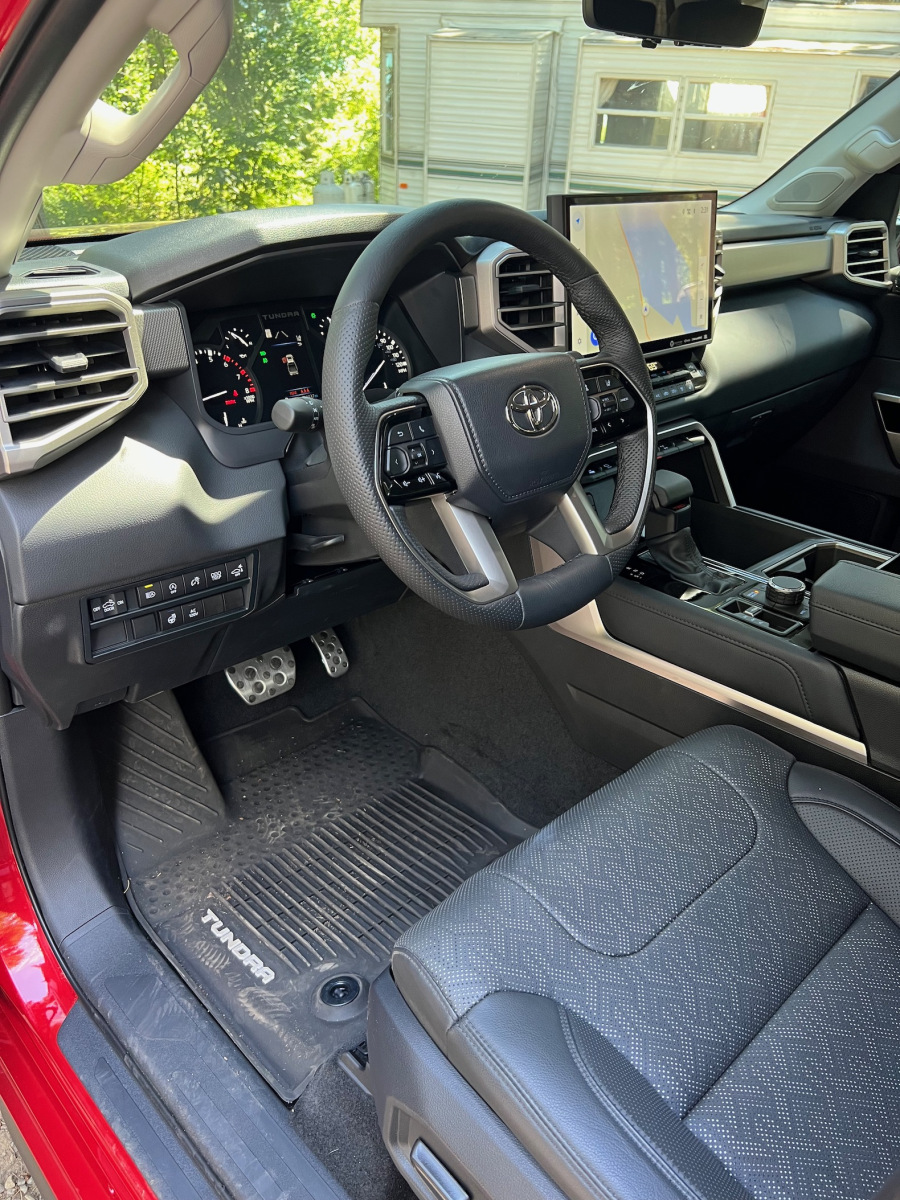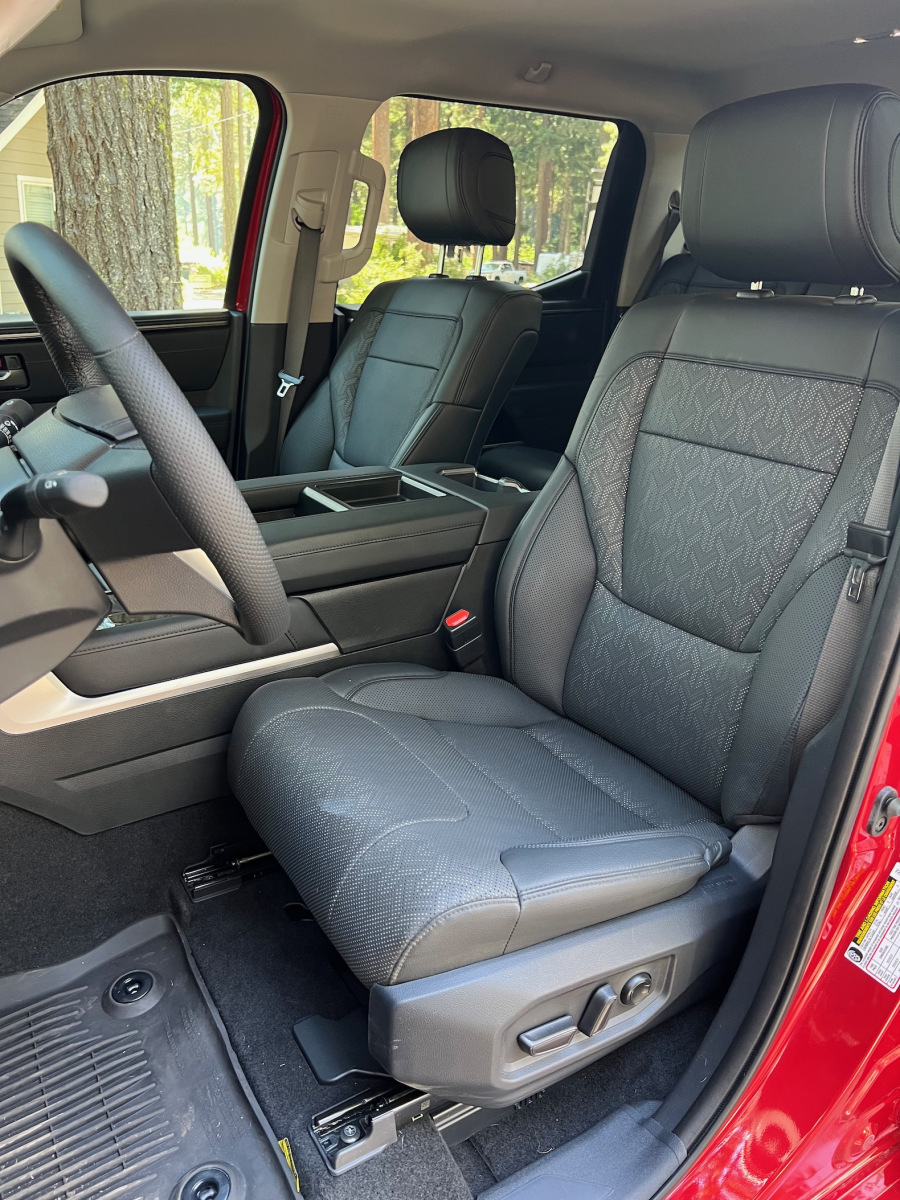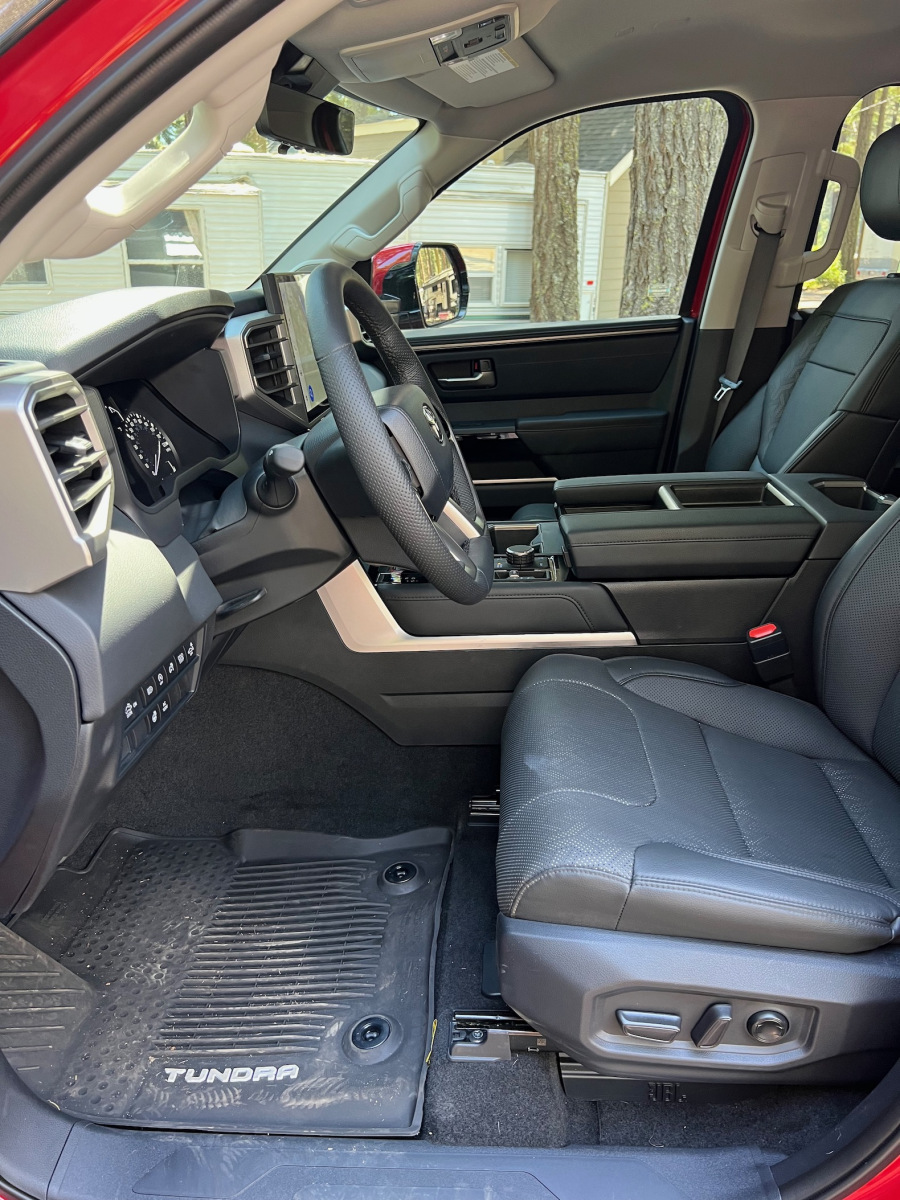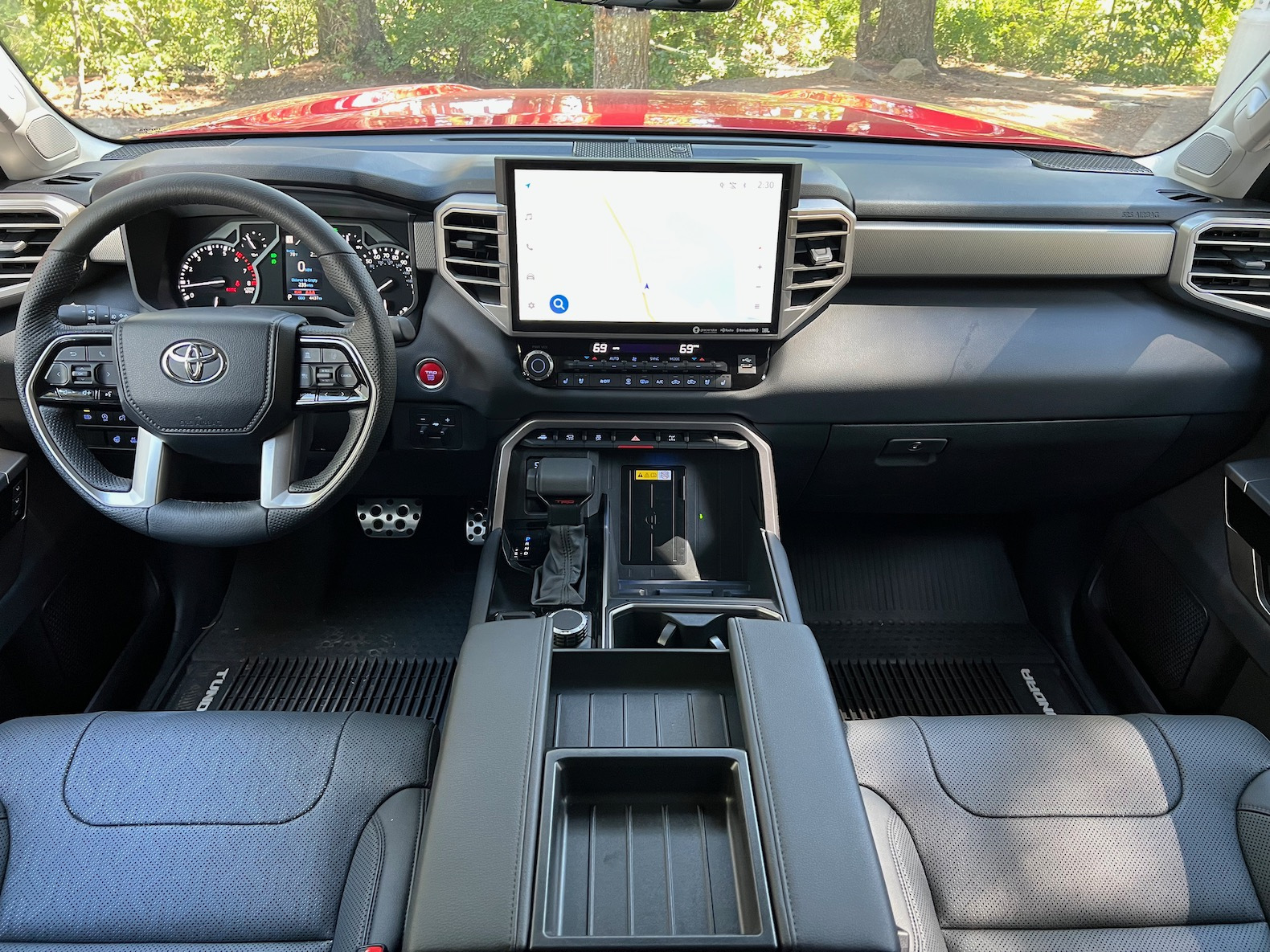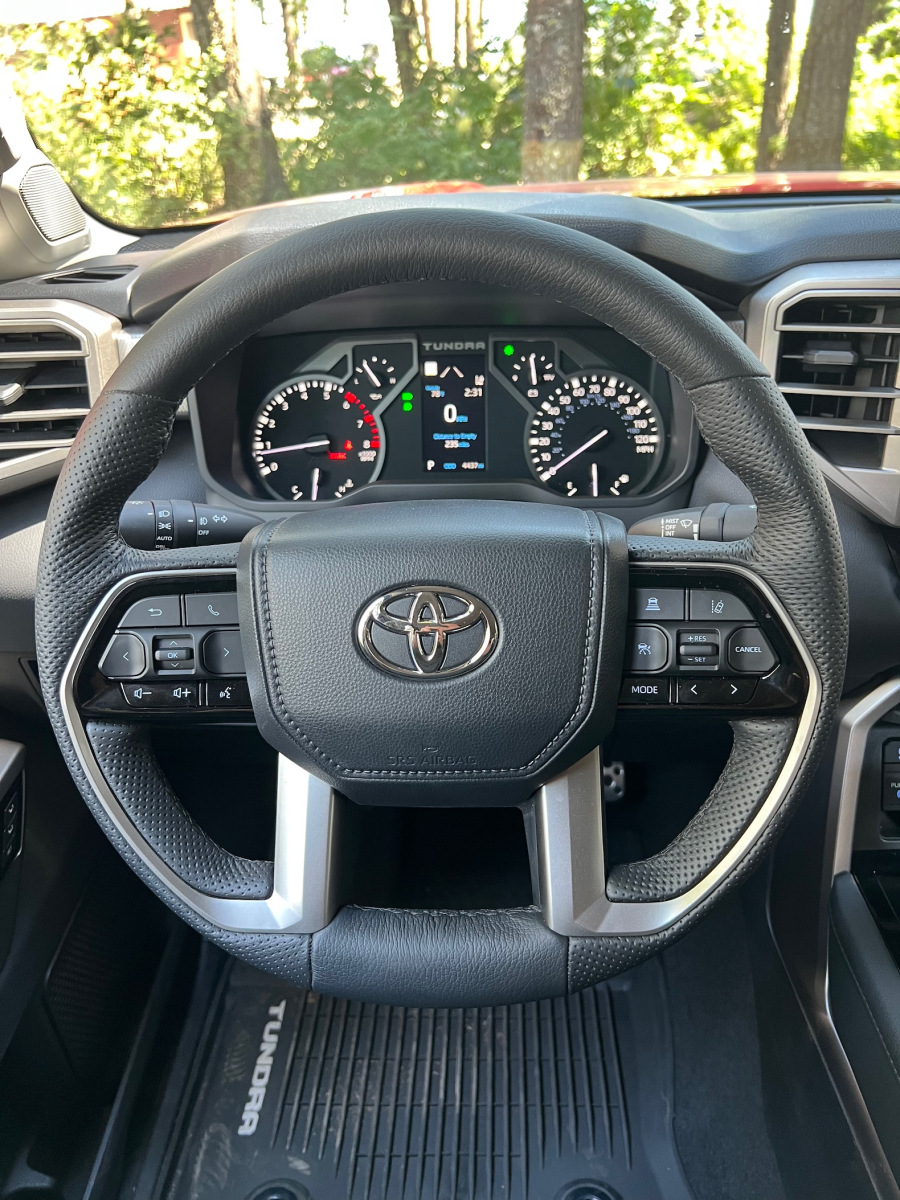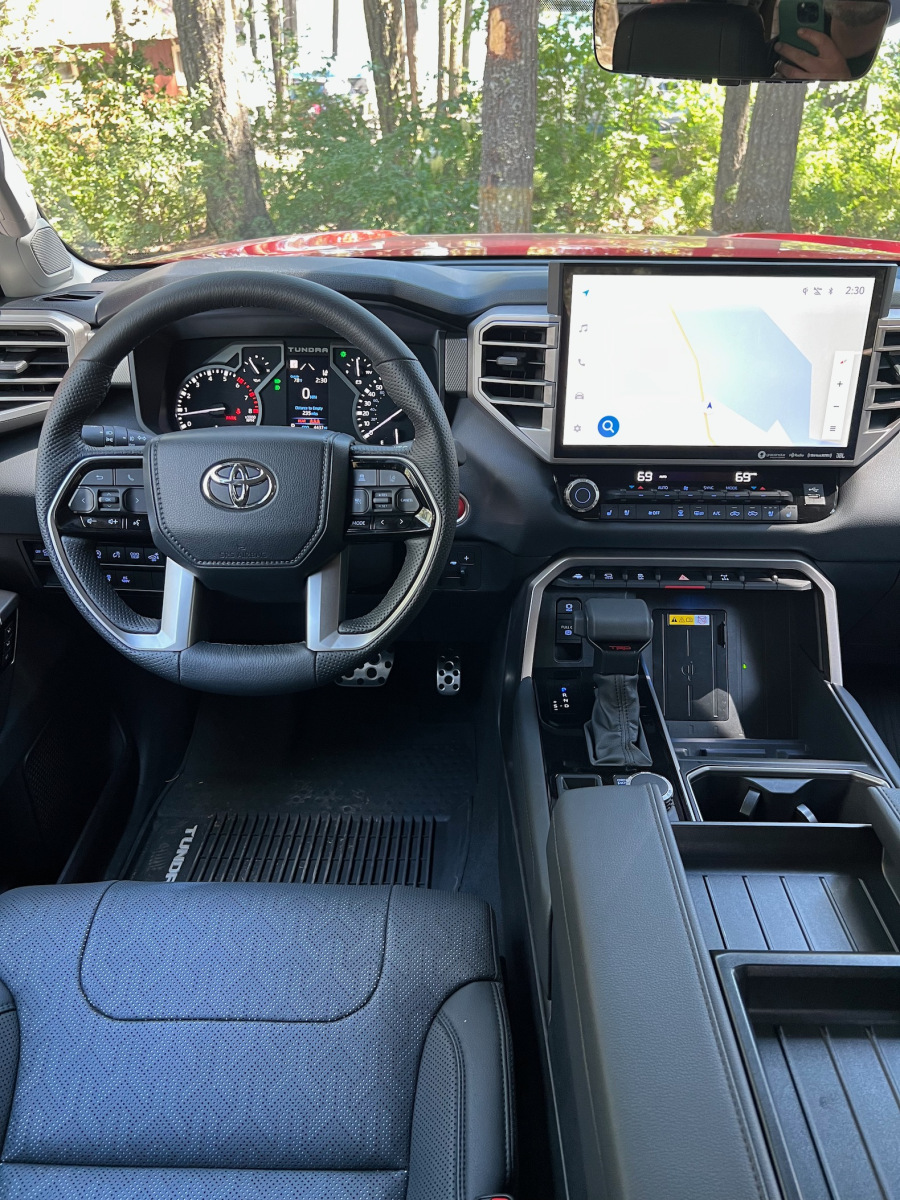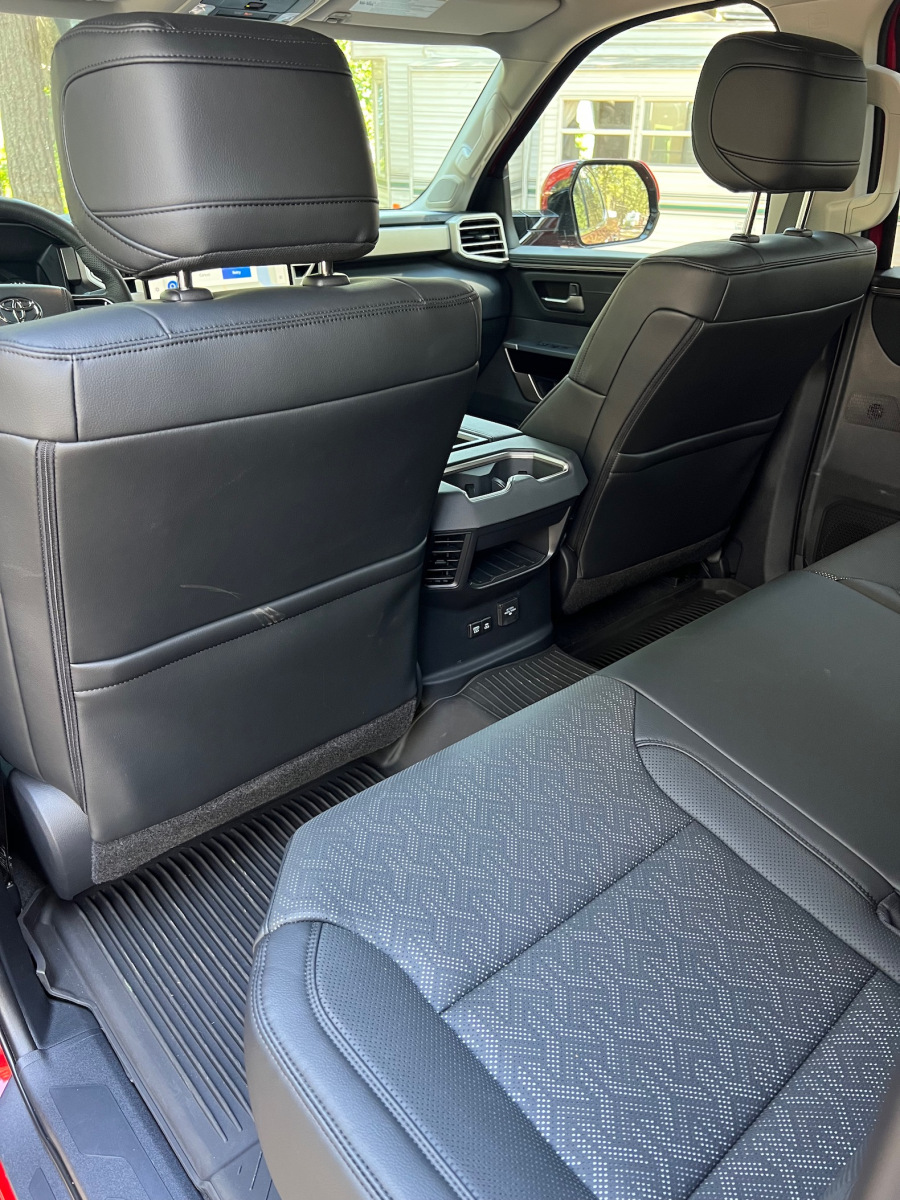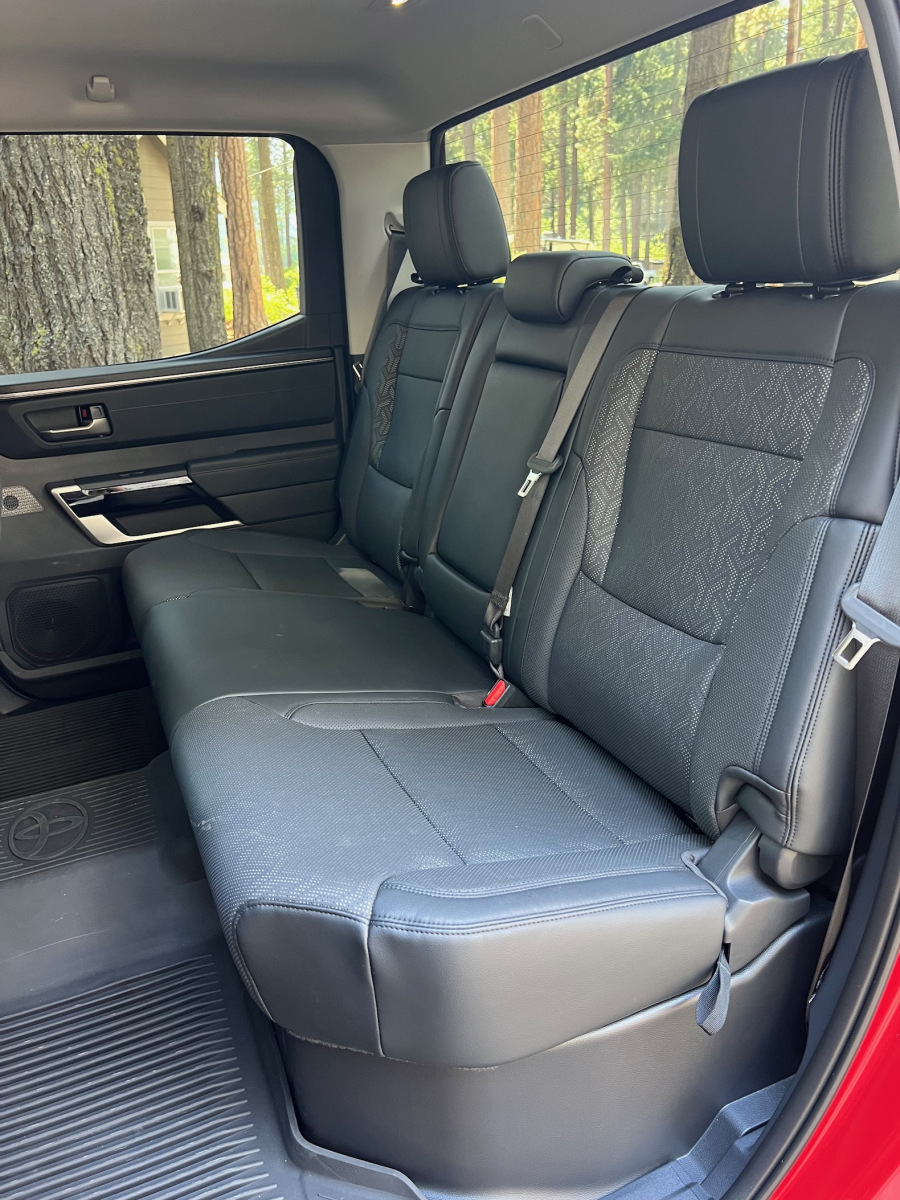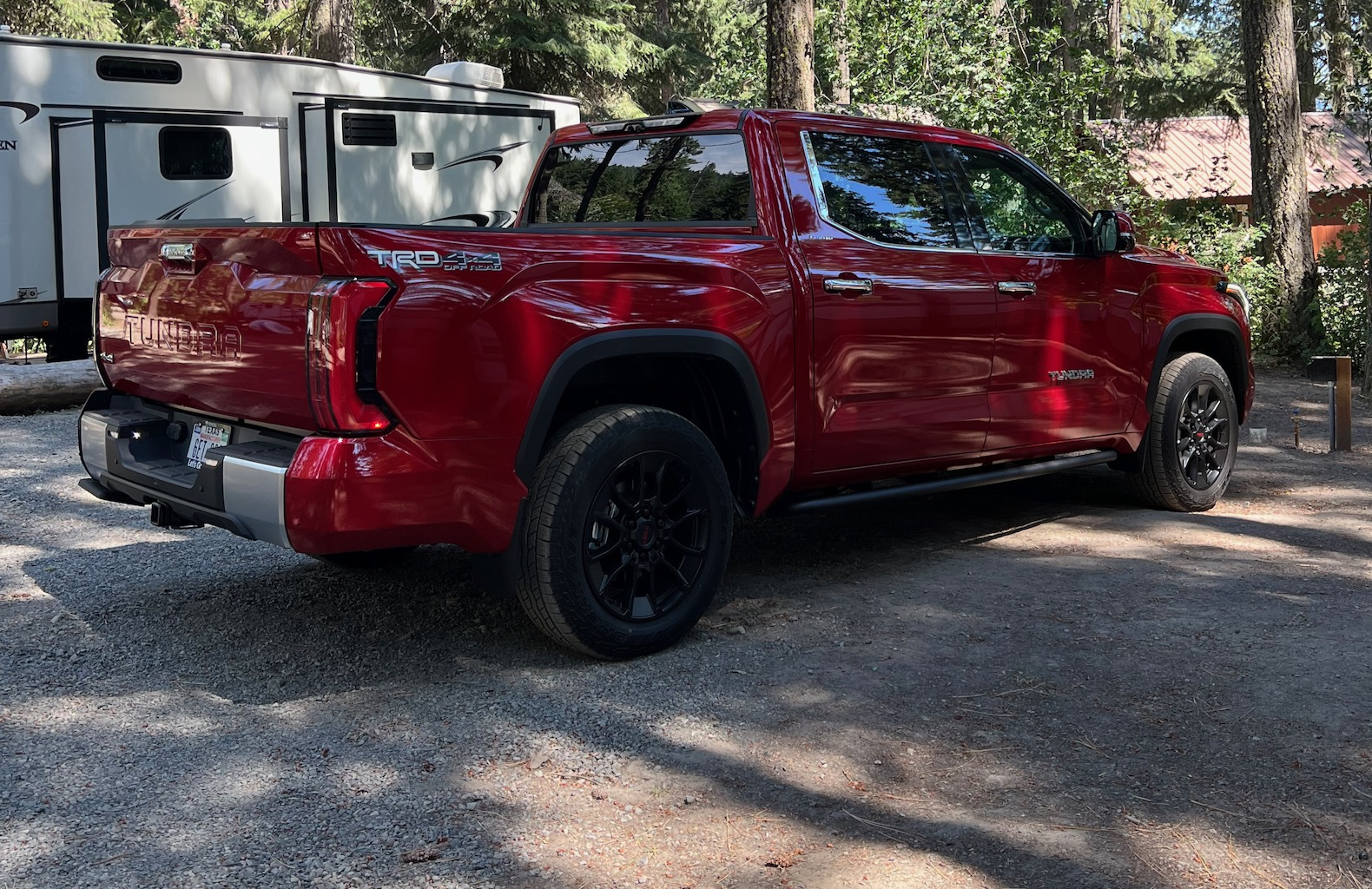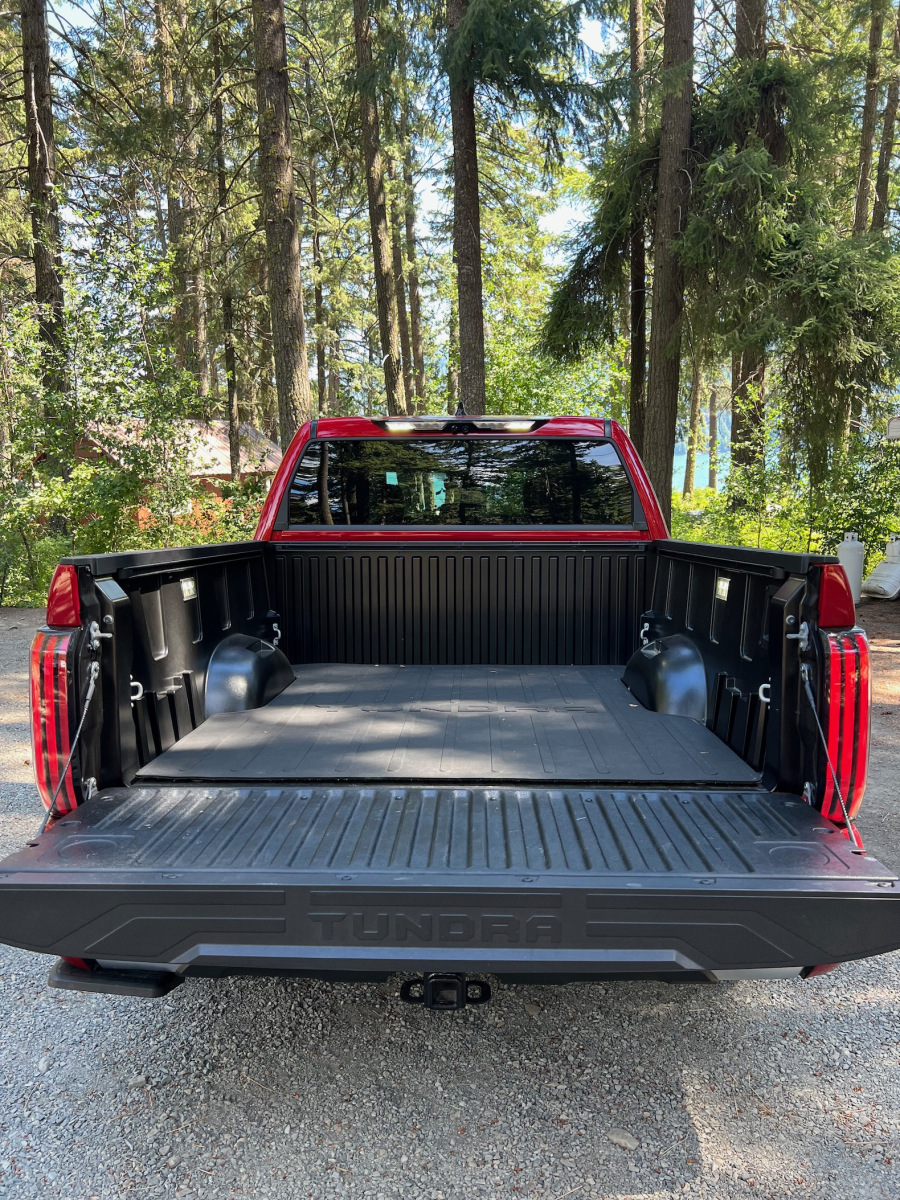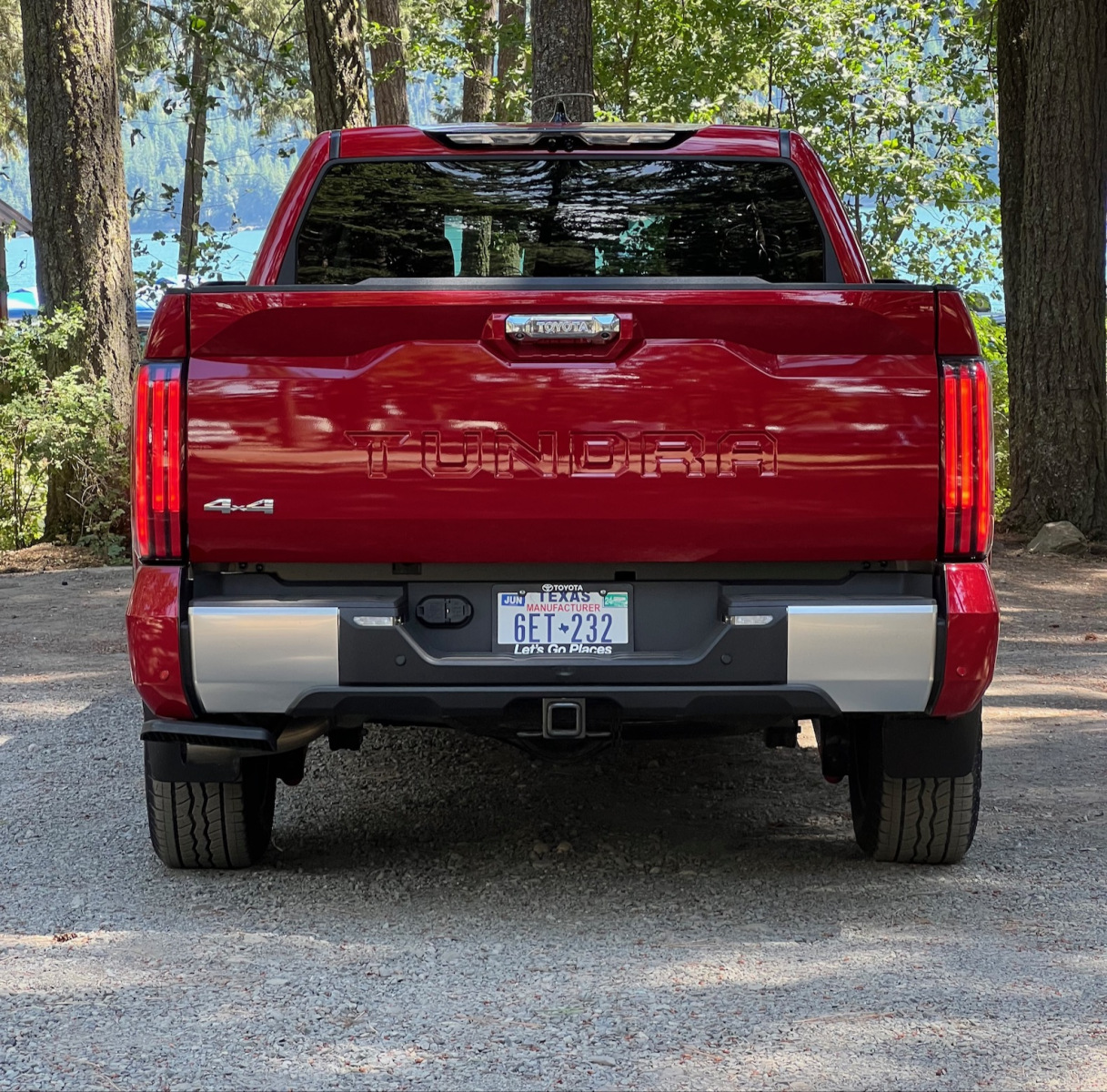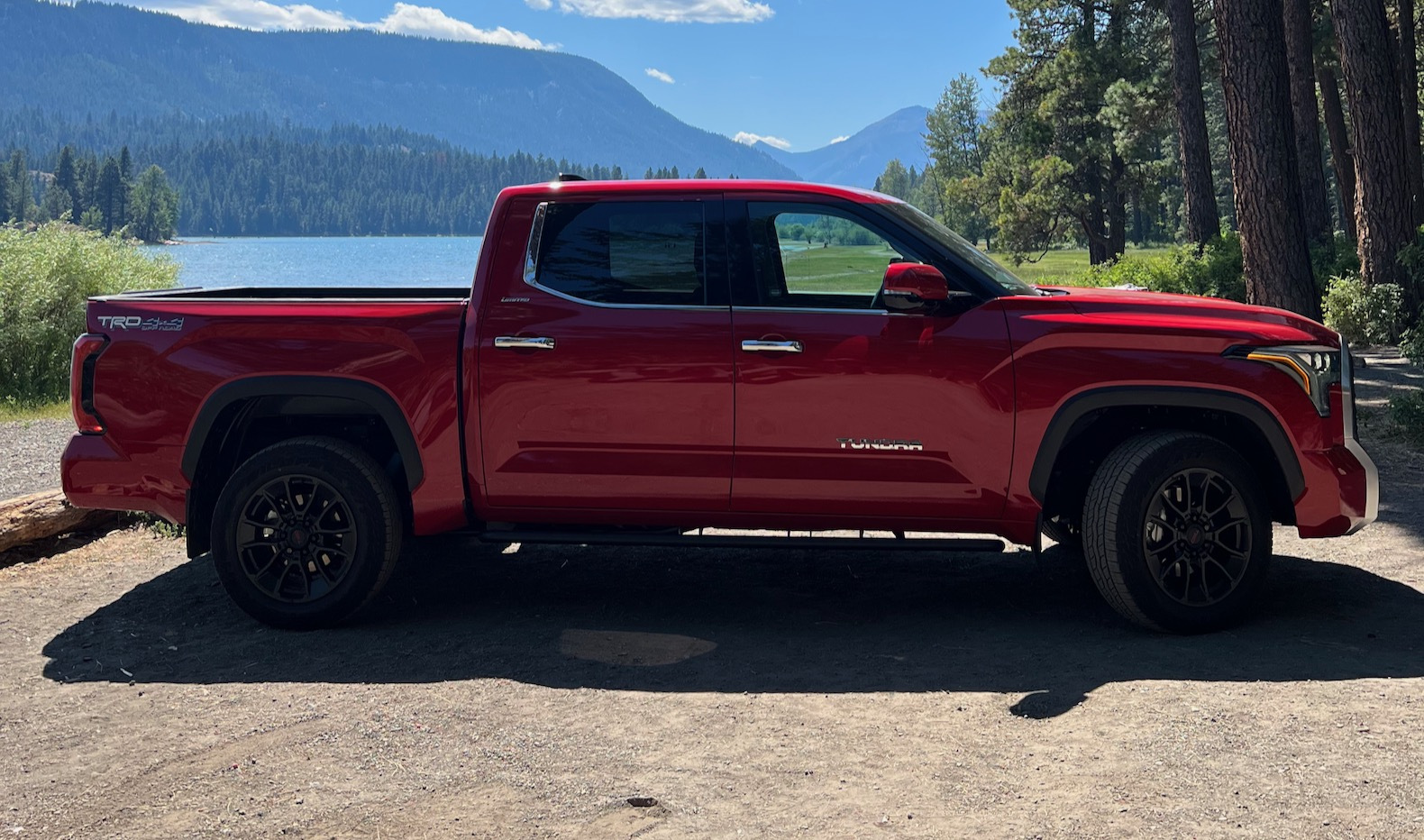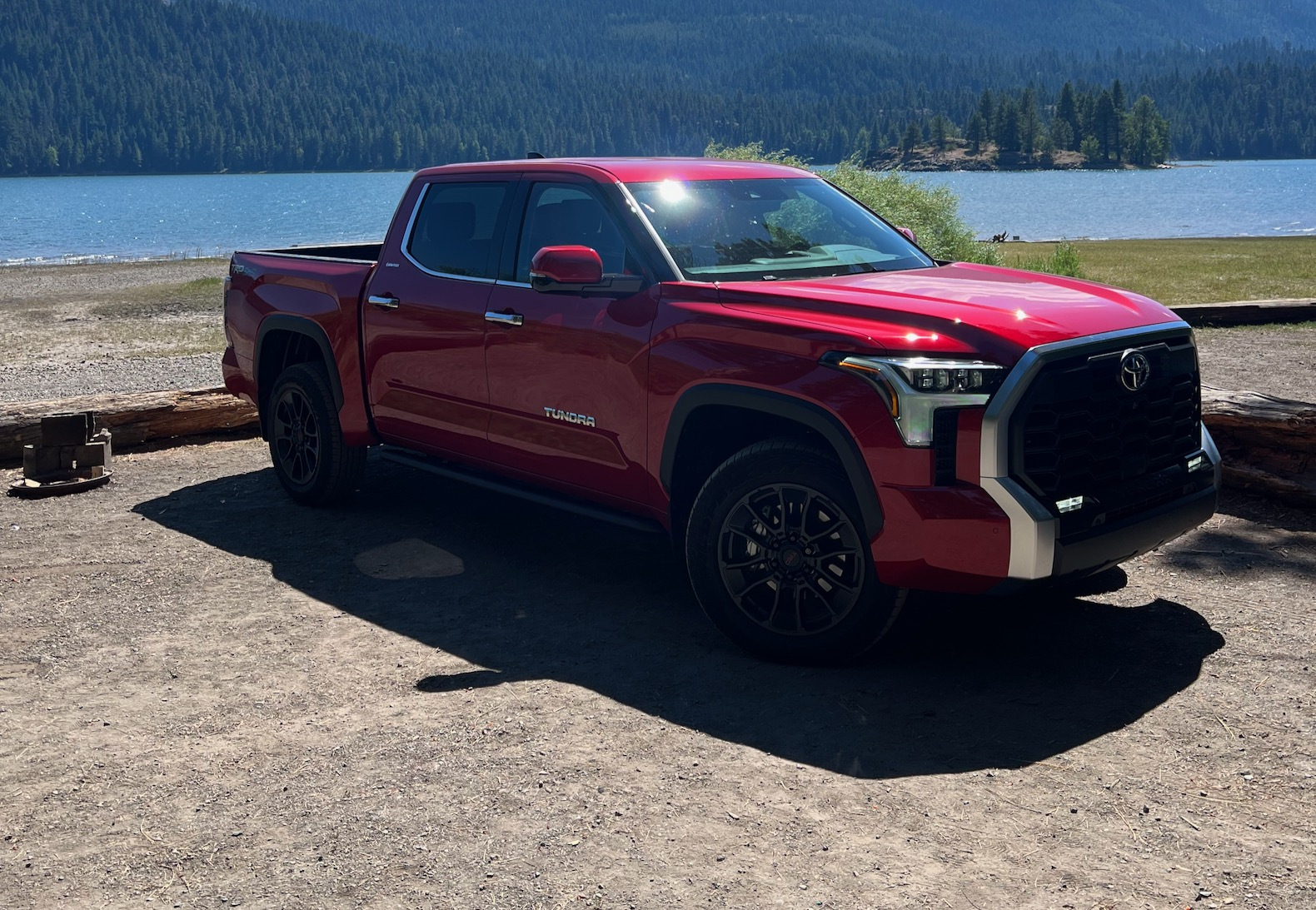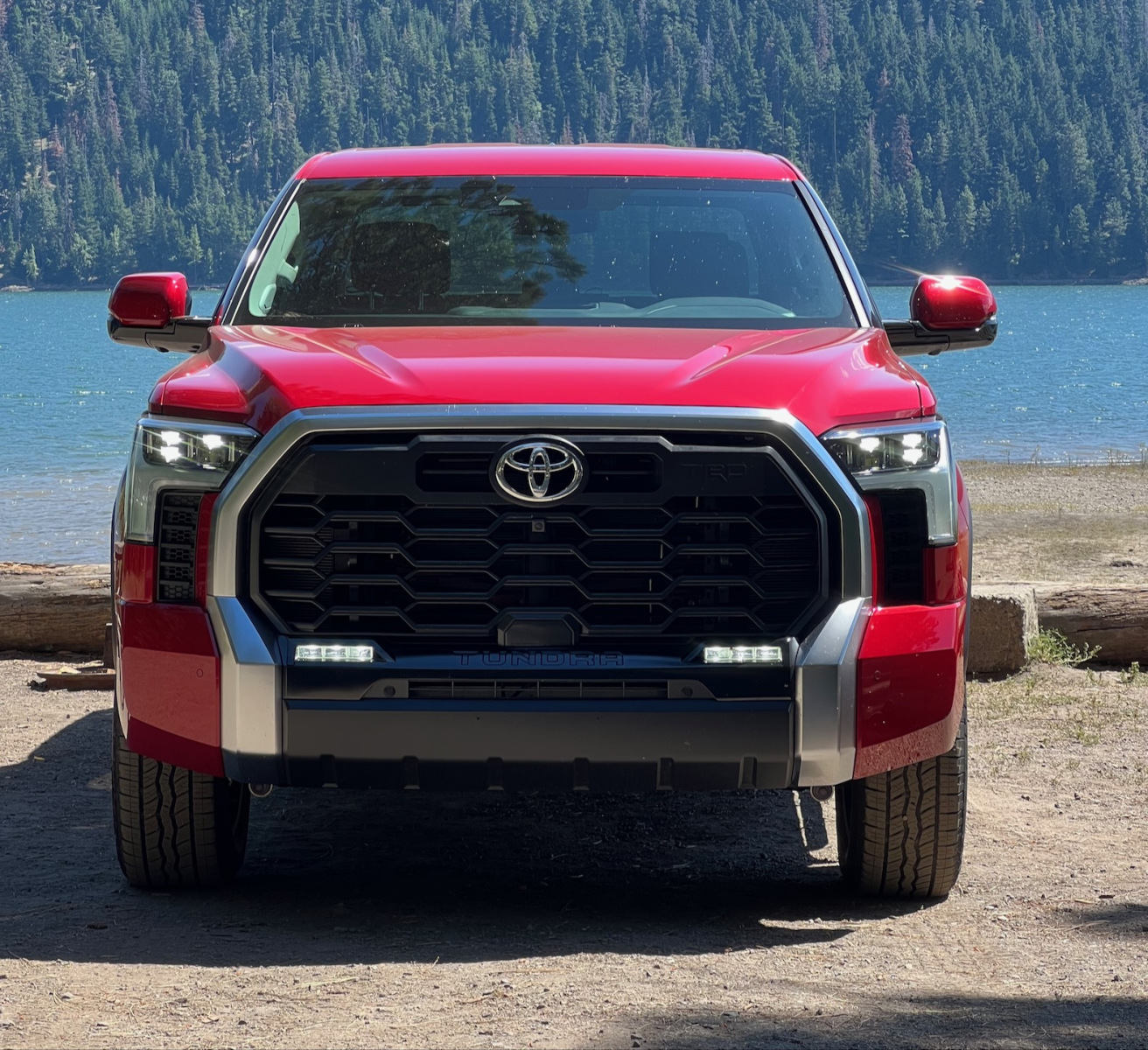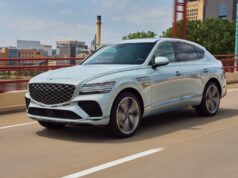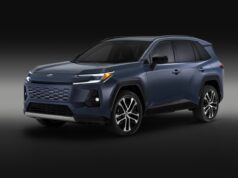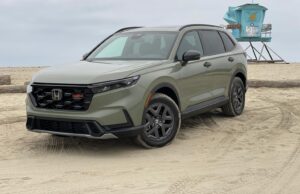The new 2022 Toyota Tundra takes a big leap forward with a hybrid powertrain, coil-spring rear suspension, and the latest tech. The Tundra is a full-size pickup truck with a new hybrid option, three beds, and two four-door cab sizes. It lacks the myriad configurations and electrification options of the Ford F-150, but embraces a coil spring rear suspension similar to the Ram 1500.
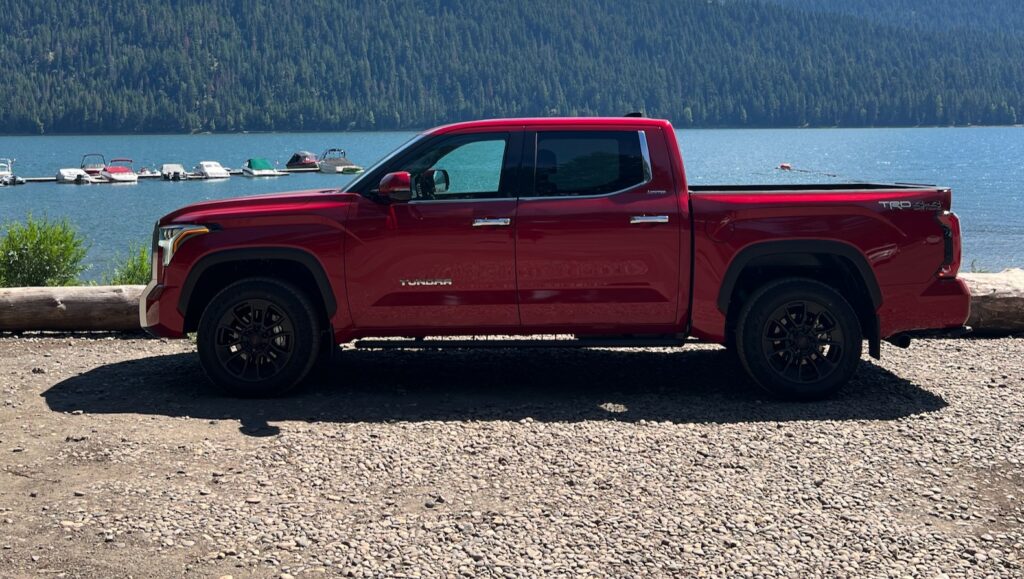
Long overdue, the redesigned Tundra steps into the present with a smoother ride, much more efficient powertrain choices, and off-road and towing technology that keeps pace with bestselling competitors. The infotainment interface demonstrates Toyota’s commitment to modernizing crucial aspects of the third-generation Tundra, and helps bump it to the top of its class
The 2022 Toyota Tundra takes a big step forward. The new Tundra is still big and bulky, but it appears to have gotten into shape compared to its lumbering, clumsy predecessor. Offered in crew cab and extended cab bodies with four doors, the new Tundra’s omega-shaped grille announces its broad presence. The redesigned truck is a tad wider, about two inches taller, and 4.7 inches longer with the short or standard beds, or 2.2 inches longer with the long bed and extended cab.
Seven grille options, of the honeycomb or slat varieties, distinguish the trim levels, with the top TRD Pro getting a light bar underneath the original Toyota nameplate. TRD Pro models have a wider track and bulging fenders that result in a width of 81.6 inches, or 1.4 inches more than the other models. Federal law requires three amber lights at the front and center, same as Heavy Duty trucks as well as the Ford F-150 Raptor and Ram 1500 TRX.
If the horseshoe shape were inverted, the arms would appear to curl over the ridged hood. Gotta work those biceps. Standard LED headlights and DRLs wrap into the big blocky fenders, stretching the truck outward. The bulging fenders and squared-off wheel cutouts are connected by a recessed character line in the lower half of the doors, and a choice of eight new 18-inch or 20-inch wheel designs complete the profile. A power liftgate can be accessed from a bump switch near the driver side taillight or by the fob.
The 2022 Toyota Tundra’s twin-turbo V-6 options give it more efficient capability. The base 3.5-liter twin-turbo V-6 puts out 389 hp and 479 lb-ft, and it’s potent enough to chirp the tires on the standard 18-inch wheels. Peak torque comes on at 2,400 rpm, and the twin-turbo setup eliminates any turbo lag. It hustles much quicker than its bulky proportions would lead you to believe. Aluminum body panels offsets some of the weight gain from the extra equipment, so the 2022 Tundra sees a slight increase to between 5,400 and 5,700 lb on crew cab models.
The 10-speed automatic transmission flicks through gears effortlessly and almost unnoticeably. It’s noticeable during passing moves at cruising speeds, however. The transmission takes a beat for its overdrive gears to downshift into seventh or lower for the necessary power.
The big news for the 2022 Tundra is an available 3.5-liter twin-turbo V-6 hybrid making 437 hp and 583 lb-ft at 2,400 rpm. A motor generator sandwiched between the engine and transmission provides boost to the engine while driving, yet the hybrid system powers engine stop/start, regenerative braking, electric assist, and EV driving at speeds under 18 mph. It’s quiet at low speeds and off-road, and is quicker and even lighter on its rubber shoes than the base V-6. The new Capstone trim and TRD Pro come only with the hybrid powertrain, but it’s offered on Limited, Platinum, and 1794 models. A 1.87-kwh nickel-metal hydride battery pack sits under the rear seats in the Tundra Hybrid, so the only loss to interior space is a lack of rear underseat storage in the Hybrid.
Rear-wheel drive is standard on the 2022 Tundra, but most shoppers traditionally choose four-wheel drive that comes standard on the TRD Pro model. All models come with an electronic limited-slip rear differential and two-speed transfer case that requires a shift into neutral to activate 4H or 4L.
The Tundra rides on a new, lighter double wishbone suspension up front and a multi-link rear suspension with coil springs that replace the old leaf springs. It handles calmly and quietly on road, with less bouncing around from the unladen bed, and not as much lean in turns. Between 65 and 70 mph, however, the cab vibrates with the available 20-inch wheels.
Of the five suspension choices, the rear air suspension might sound like the most advanced but its limited to three heights for specific purposes: the Low setting defaults to Normal above 8 mph, and is mainly for loading and unloading the bed; the High setting defaults to Normal above 18 mph and is meant for low-speed off-roading. A manual switch on the center stack lets you change between the three settings within the speed parameters, but the automatic setting is simpler.
Available adaptive dampers, similar to what’s used on Lexus’s performance vehicles, smooth over road imperfections for a more comfortable street drive, but they have to be paired with the air suspension. Models with the adaptive dampers get Sport+ and Comfort modes that affect damper stiffness and steering feedback.
Available on SR5, Limited, and 1794 models, the TRD Off-Road packages swap out the standard twin-tube shocks for monotube Bilsteins, 18-inch or 20-inch TRD wheels, a special grille, skid plates, mud guards, and on 4WD models, an electronic rear differential lock. TRD Pro grades get 2.5-inch Fox internal bypass shocks with a 1.1-inch front lift, a TRD-specific front stabilizer bar, aluminum front skid plate, and all-terrain Falken tires.
The 2022 Tundra climbs off road easily, but the wide proportions of the TRD Pro model can make it a challenge negotiating tight turns flanked by trees. Still, it’s smoother, quieter, and technologically easier than the old model. Standard on TRD Pro, a hill descent control button enables pedal-free driving down studded slopes so you can better concentrate on the obstacles; through the console dial, you can adjust the speed from 3-18 mph or override it entirely with a press of the throttle. It lacks the jerkiness of more rudimentary systems.
The same button also enables a Crawl mode that does the same kind of low-speed cruise control but uphill. Ground clearance reaches to 10.9 inches on the TRD Pro (11.2 inches with the SR5 crew cab) and applying the High setting on the air suspension better protects its differential from getting bashed. Available side mirror cameras project what can’t be seen between the wheels, and combined with the front camera, it gives you all the eyes you need to climb a narrow rocky ascent without a spotter. The new side mirrors also come with LED trailer lights that project rearward to illuminate the side of the trailer to ease night parking.
Two tow haul modes come on all but the base model, with Tow+ mode delaying shift response and changing the throttle mapping to better tow loads more than 5,000 lb. There’s more heft to the steering, and compression is reduced on the air suspension for a steadier load. The only lag from the twin-turbo comes from the weight behind the truck. The hybrid gets moving even quicker, and doesn’t strain uphill. Towing capacity maxes out at 12,000 lb with the SR5 extended cab with the standard engine.
The brake gain setting can be set in increments of .5 up to 10 to control trailer sway and apply more braking to the trailer when towing heavier loads or over long, steep downhill grades. Up to 10 trailer profiles can be loaded into the system, with manual entries for length of the trailer that can also be detected by the multitude of cameras. Toyota’s reverse trailering helper called “Straight Path Assist” relies on your perception of straight when lining up the trailer with the desired destination. An available surround-view camera system projects bird’s-eye views of the truck and trailer, the cargo bed, and the hitch on the large infotainment screen.
The 2022 Tundra’s twin-turbo V-6 is much more efficient than the outgoing V-8. It is much better than the retired V-8, which had an EPA-rated 13 mpg city, 18 highway, 15 combined with rear-wheel drive. Toyota estimates the Tundra hybrid at 20 mpg city, 24 highway, and 22 combined with rear-wheel drive, and 19/22/21 mpg combined with 4WD, which significantly trails the 2022 Ford F-150 Hybrid and its 24 mpg combined rating for 4WD. The base twin-turbo V-6 will get 18 mpg city, 23 highway, 20 combined in rear-wheel drive; four-wheel drive costs it 1 mpg across the board.
The 2022 Tundra makes occupants and other vehicles safer with its standard safety features. There are no ratings until the IIHS and the NHTSA crash test the redesigned Tundra, but it is one of the best equipped full-size trucks when it comes to mitigating and avoiding crashes. Every Tundra comes with automatic emergency braking, adaptive cruise control, active lane control, automatic high beams, hill-start assist, and a rear-seat reminder. Options include blind-spot monitors, a surround-view camera system, and side-mirror cameras.
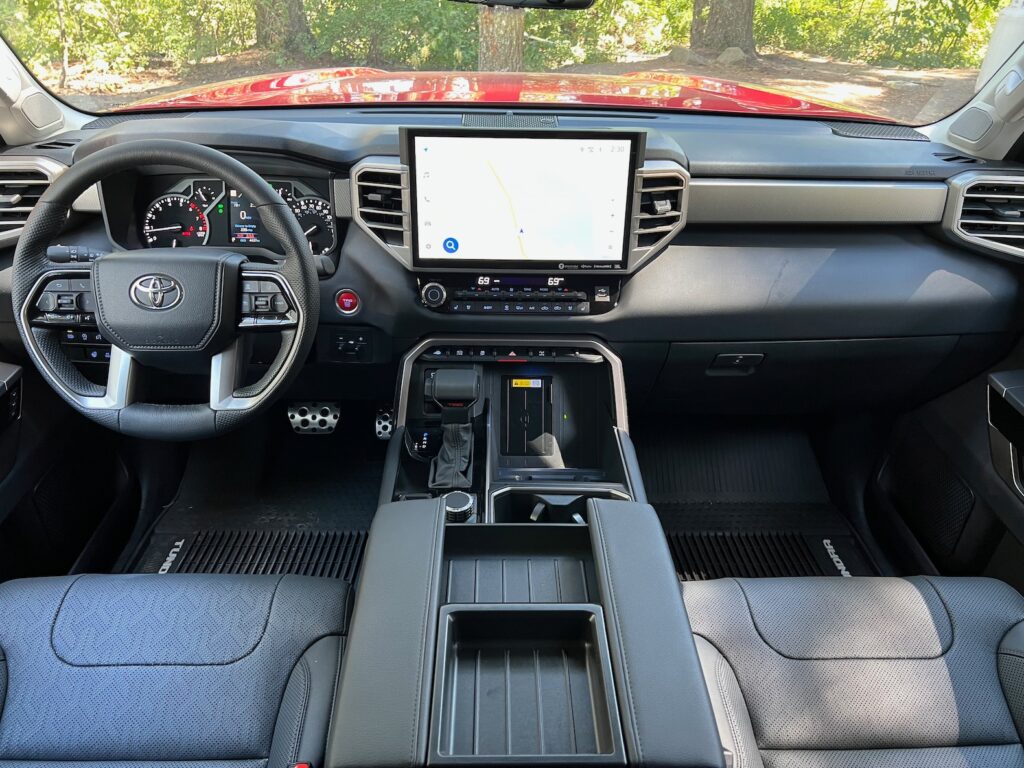
The interior makes enormous strides away from the old model, with large touchscreens integrated into a dash that can be trimmed in walnut, leather, and other warm touches. The plastic vents diminish the dash quality, though. Icons identifying the toggles for temperature and fan speed are recessed below the touchscreen and hard to read, but owners should get used to it within a few days. A gear shifter occupies a wide center console with available wireless smartphone charging, padded armrests, and other soft-touch materials on most trims.
The 2022 Toyota Tundra crew cab comes with either a short or standard bed for the first time. The Tundra’s proportions don’t translate to much more interior space since the wheelbase remains the same (145.7 inches for the short bed, 157.7 inches for the crew cab with standard bed, 164.6 inches with the extended cab and long bed). Head room improves about an inch to 41.0 inches, unless it’s optioned with the panoramic sunroof that shaves nearly two inches from that spec. Crew cab rear leg room decreases nearly an inch from the old model, but at 41.6 inches there’s not only plenty of stretch out space, there’s also more leg room than up front. The extended cab’s rear leg room also loses 1.4 inches down to 33.3 inches, which is narrower than most compact crossovers.
For synthetic leather upholstery and 8-way power front seats, Tundra shoppers can select a package on the SR5 or step up to the Limited trim and its heated and cooled front seats for a bit more comfort and refinement. For Toyota’s finest truck finishes, consider the Platinum’s leather or the 1794’s walnut wood trim, ambient lighting, and illuminated footwells. The Tundra might not be as ritzy as some rivals’ executive trims but the interior can still be a cocoon of comfort and it won’t require an executive-level salary.
A power rear window remains an option, so the whole family of dogs can stick their snouts into the breeze or check on the action in the bed. Tundra can be had with a 5.5-foot short bed, 6.5-foot standard bed, and an 8.1-foot long bed exclusive to the extended cab. The short bed is about an inch longer than the outgoing model, but the other bed sizes are shorter by about an inch. For the first time on a Tundra, the crew cab can be paired with the standard bed as well as the short bed.
Aside from electrified powertrains and massive touchscreens, pickup truck beds remain the last frontier of incremental innovation, and Toyota doesn’t revolutionize here. A bump switch standard on Limited and above trims lets you hip check or elbow a button between the driver’s rear fender and the taillight to power release the tailgate. Pair it with a power corner step for easier access to the bed. The inside of the beds lose about an inch in length, depth, and width due to the new resin composite shell that protects against rust and dings compared to a steel bed. It’s wide enough to slide sheets of plywood between or above the wheel wells.
Large touchscreens and wireless smartphone connectivity show how much the 2022 Toyota Tundra has evolved. If you were to compare the tech and features in the old versus the new Tundra, it would be hard to believe that one grew out of the other. It earns points on our scale for the following reasons: An 8.0-inch touchscreen with wireless Apple CarPlay and Android Auto highlights the standard features; a revamped infotainment system developed and designed in the U.S. welcomes instead of frustrates users; options and packages let owners customize the truck from a luxurious road king to an off-road beast; and its price range is expected to be a value compared to rivals.
The biggest tech news for Toyota’s biggest model is the 14.0-inch touchscreen available on the SR5 and standard on Limited and above models. Debuting simultaneously in the 2022 Lexus NX, the setup sports a fresh font, sharper visuals, pinch-and-zoom functionality, enhanced voice commands, dual microphones for both front passengers, and it has five times greater processing speed, according to Toyota. It doesn’t have the deep dives of other large touchscreens, but the layout is clear and easy to navigate. A left menu bar keeps the iconography simple, and though some navigation functions on the right side are a reach for the driver, they can be overcome by pinching and zooming. CarPlay takes up the whole screen and can be used simultaneously with the native navigation, so you could make a call and still have map guidance; two phones can be paired at once.
A large volume dial comes on either the 14-inch or standard 8.0-inch touchscreen. Standard equipment includes wireless Apple CarPlay and Android Auto, three USB ports, keyless start, power features and a power tailgate. Options include a panoramic roof, heated and cooled front seats, and heated steering wheel. An available 12.3-inch digital instrument cluster comes standard with the hybrid engine and on Platinum, 1794, and TRD Pro models. The standard cluster on SR and SR5 models has a 4.1-inch vehicle info display. A wi-fi hotspot enables connections for up to 10 devices, and available navigation stays fresh with over-the-air updates.
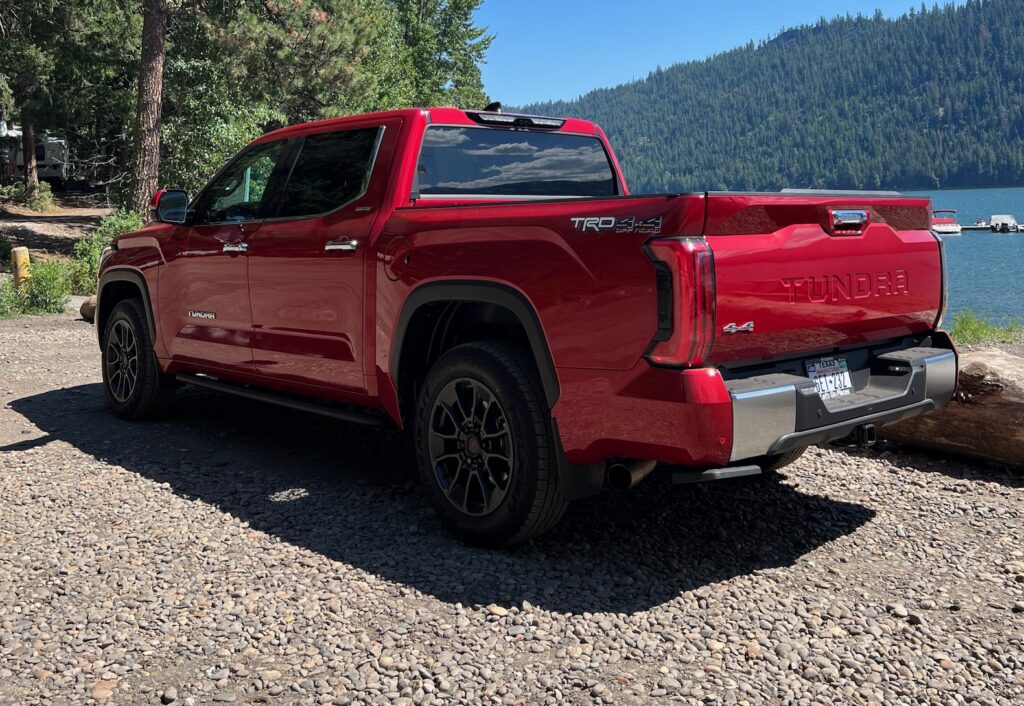
The base Tundra SR costs $37,645, including a $1,695 destination charge. Our compass needle points to the Limited trim, which, together with the SR5, accounted for about 70% of sales of the outgoing model. The Limited adds the bump switch on the power tailgate, heated power side mirrors, the 14.0-inch touchscreen, a 12.3-inch digital gauge cluster (Hybrid only), power rear window (crew cab only), synthetic leather seats with 8-way power front seats, heated and cooled front seats, soft-touch console and door panels, leather-trimmed steering wheel that’s heated, and blind-spot monitors. We’d get the Limited Hybrid for more power, more torque, and greater acceleration or efficiency.
The Platinum and 1794 trims essentially get the same equipment but with different finishes, such as the walnut wood dash trim on the 1794. The $68,500 TRD Pro hybrid with four-wheel drive attracts off-roaders, but the new range-topping Capstone hybrid with a crew cab, four-wheel drive, and a 5.5-foot bed takes a big leap to $75,225. On the outside, it flashes more chrome and a distinct honeycomb grille, 22-inch chrome wheels, power running boards, and a power bed step out back. Inside, it features two-tone perforated leather trim, open-pore walnut trim, a heated steering wheel, a panoramic sunroof, and acoustic glass on the front doors that quiets the ride. But the surround-view camera system and rear air springs cost extra. Toyota provides a 3-year/36,000-mile basic warranty on the 2022 Tundra, along with factory scheduled maintenance and 24-hour roadside assistance for two years or 25,000 miles.
Reviewing the 2022 Toyota Tundra is effortless, just like the truck itself. Toyota’s decades of refinement culminate in the best Tundra ever, there is literally something for everyone. From impressive efficient powertrains and capacities, refined on and off-road driving dynamics, and cutting-edge technology; Toyota has clearly done their homework. While some would argue that 15 years was enough time for Toyota to do their homework, we’re glad the all-new 2022 Toyota Tundra is here and at the top of its game.

